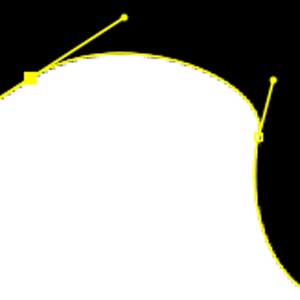Although the course that I did at Escape Studios was called ‘Complete Compositing’ the larger post production houses would not usually hire someone as a compositor that didn’t already have some experience working on feature films. I was always expecting to have to start in a paint and roto department. Paint and rotoscoping are two separate disciplines but both are staples for compositing.
Rotoscoping involves ‘cutting out’ parts of a live action plate that the compositors need separately from the rest of the shot. This needs to be done if the objects couldn’t be shot as separate elements in front of blue or green screens.
The process involves tracing around the objects on a particular frame and then animating the shape to match the outline of the object as it moves through the shot. This can be a slow and manual process.
At Framestore we used a piece of software called Silhouette for our roto work. Once we had completed the rotoscoping we rendered our shapes out as black and white mattes that the compositors could use to isolate the objects.
The paint tasks involved removing things that were in the shot that weren’t supposed to be there in the final shot. An example would be painting out wires supporting an actor during a stunt but most often it seems to be removing markers placed in the shot to help the camera tracking department.
I was hired as Framestore was ramping up for Where The Wild Things Are. Because we were animating the faces on all of the monsters, each monster had about 10 markers on them. These had to painted out in every shot.
There is a blurred line between the paint work and compositing so most of the paint work was done in Shake, with Nuke starting to take over by the end of my time in the department. Silhouette also had excellent paint tools and was sometimes used as well.
During my time in Paint and Roto I also worked on Avatar, Clash of The Titans and Salt.
Although the paint and roto department is not as glamorous as compositing, and I certainly wouldn’t want to have worked there forever, I am really glad I spent a year there. I learned a huge amount and worked on shots that I am still proud of.
This was the first time that I had worked with footage from film instead of video so I had to deal with grain and colour spaces. I learned loads of techniques and completed shots that I would never have thought were possible before I started.
More importantly I learned a lot about working on a high profile film project. I was surprised at how closely my work was scrutinised before it was approved and the sort of things that were noticed and sent back. In my previous jobs I had never had my work checked frame by frame while the viewer lifted the brightness to check the darkest areas of the shot that the naked eye could never see.
Working to this standard on these projects really prepared me for my move into compositing.




Thanks for this post. Found it interesting!
hi CONRAD OLSON
very nice blog for me its very useful man thank you a lot……
Dear sir mam I would like to apply for the position of roto paint artists . My SKILLS: Photoshop, Silhouette, Nuke
“To deliver a position that allows application of my knowledge, good usage of my strengths and skills, exposure to most modern technologies and making a significant contribution towards the growth of organization.”
hi im prasanth i have more than 5 years experience in paint and prep some domestic comp also i have done. I like to join i ur company so please let me know is there any vaccant is available.
Thanks.
Thanks a lot for this post
I have a doubt do compositing artist should learn about any 3d software ??
Do you know any 3d software??
If so then where should I learn 3d software and which should I learn???
Hi Ritin,
I have never really learned any 3D software. But I do know the 3D tools inside Nuke fairly well.
If you are a compositor at big company then they will expect you to be able to use the 3D system in Nuke, but they wouldn’t expect you to know anything else. There are other departments to do that for you.
If you are at a smaller company it might be useful if you could do some basic 3D stuff too. If you were going to learn anything other than Nuke I would say learn Maya and maybe a camera tracking tool. Camera tracking is the most useful 3D skill for a compositor, and Maya is still the most use 3D application in the industry.
I have learned a lot of information about the 3D side of things. I know what should and shouldn’t be possible in 3D, I know what kinds of things I can ask for from other departments, I know the terms that they use so communicating with 3D artists is easier. I just don’t know how to actually do any of the things I know about.